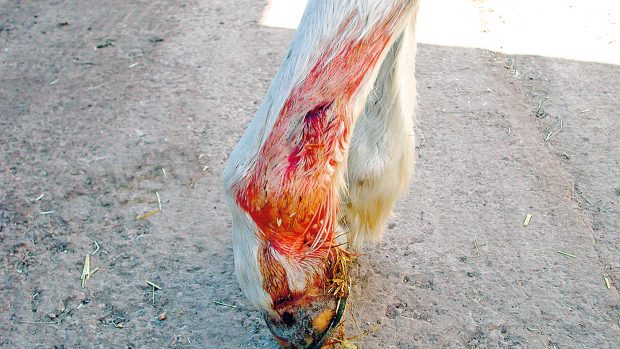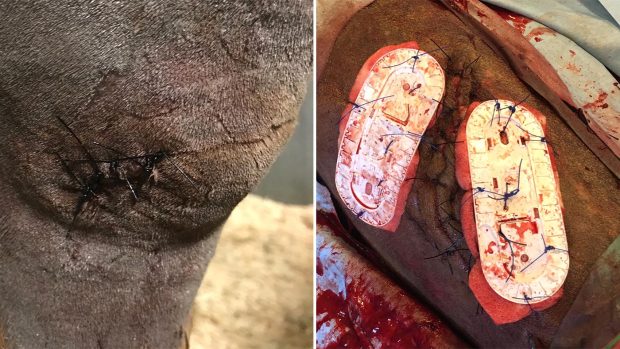One of the most common problems encountered in an emergency situation is a wound: the nature of the beast means horses tend to injure themselves, either by kicking each other or somehow colliding with solid objects. Certain horses are also injury prone and seem to hurt themselves however careful you are.
Although wounds have not changed, first-aid treatment has improved. Relatively new water-soluble wound gels have replaced traditional wound powders and the various coloured sprays. Originally designed for human burns patients, these gels are also very useful in horses.
Wound hydrogels can be applied to the area of damage, helping to keep it clean and moist. It is thought hydrogels reduce the number of bacteria in the wound and can speed healing. They are a useful addition to any first-aid kit and a safe and satisfactory answer to the question: “What shall I put on a wound?”
There are various such products on the market, including Derma-gel, Vetalintex, Intrasite gel and Nugel, all of which are useful to apply to open wounds.
The healing of a wound is influenced by the way it is managed straight after an accident occurs, so your immediate action is important and should include the following:
- If possible, move the horse to a safe place so that it is not likely to injure itself further or cause injury to others
- Control any bleeding, usually by applying pressure to the wound
- Assess the injury and call the vet if necessary
- Protect the wound from contamination and further injury. Cover the wound where possible to protect it. It is important to remember that raw tissues are exposed and will be painful
- Assess whether the horse is shocked or just very sore. It helps to check how it can walk and whether it is lamer than one would expect
- Clean the wound
- Prevent or control infection
- Prevent or reduce swelling
Another essential first-aid rule is that contamination and infection prevents wound healing. If infection penetrates vital structures such as joints or tendon sheaths, a horse may be permanently crippled. Hence it is vital to check the position, depth and severity of any wound carefully. To do this properly, you must clean the wound, so you can see what is involved, provided this can be done without making it bleed further. Cold hosing can be very effective here.
Always contact your vet if:
- Any wound is bleeding profusely
- The horse is very lame, even if the wound itself is small
- Any wound is more than a couple of inches long and has gone right through the skin, so that it gapes open and may need to be stitched
- There is any suspicion of a foreign body in the wound
- There is any suspicion that a vital structure such as a joint may be involved
- The horse has NOT had an anti-tetanus vaccination
If you think a wound may need to be sutured (stitched or stapled), you should consult your vet as soon as possible, since a wound will heal more effectively if it is sutured while still fresh. This does not mean your vet has to attend instantly, as there is a 6-8hr optimum period for wound repair.
A wound may need to be sutured if:
- The edges are gaping apart, leaving a large gap for dirt to enter
- It is very large or deep
- It is in an awkward place that will scar
In most cases, deep punctures, injuries with very swollen or crushed wound edges or severely contaminated or infected wounds will not be suitable for suturing, nor will wounds that are more than 8hr old. Your vet will be able to advise you what is best for any particular wound. Many wounds that look appalling at first inspection will repair very well, given time and proper care.
Another innovation is the use of surgical skin staples, which are now often used instead of stitching for certain types of skin wounds. They can be inserted very quickly and may be ideal when a horse does not want to stand still. Staples do not work well for jagged injuries or when the wound edges are under a lot of tension, but they are often a neat and efficient way to repair clean cuts.
Large wounds often do very well, whereas small puncture wounds are frequently far more serious, since they may penetrate vital structures, introducing crippling infection.
|
SUBSCRIBE TO HORSE & HOUND AND SAVE Enjoy all the latest equestrian news and competition reports delivered straight to your door every week. To subscribe for just £1.43 a copy click here >>
|




